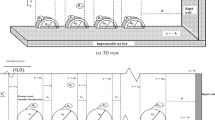Abstract
The diffraction of multidirectional random surface waves with one or more rectangular submarine pits is investigated theoretically. A specified discrete form of the Mitsuyasu directional spectrum is used for the incident wave conditions. The present method is based on the cumulative superposition of diffraction solutions for linear Airy wave theory obtained by a two-dimensional boundary integral approach in water of uniform depth. The results of the present model have been validated through the comparison with those obtained by previous works for both regular and random wave diffraction by single or multiple pits. In accordance with good agreement from these comparisons, it is concluded that the present numerical model may accurately be utilized to predict the wave field around multiple submarine pits or navigation channels in many practical applications.
Similar content being viewed by others
References
Briggs, M., Thompson E.F. and Vincent C.L. (1995). “Wave diffraction around breakwater”.J. Wtrwy., Port, Coastal and Ocean Engrg., ASCE, Vol. 121, No. 1, pp. 23–35.
Gaillard, P. (1990) Wave spectrum changes in harbor, in Le Mehaute, B. and Hanes, D.M., The Sea, Vol. 9, Wiley-Interscience & Sons, New York, N.Y., pp. 1105–1137.
Goda, Y. (1985) “Random seas and design of maritime structures,” University of Tokyo Press, Tokyo, Japan.
Hilaly, N. (1969) “Water waves over a rectangular channel though a reef,”Wtrwys. and Harb. Div., ASCE., Vol. 95, No. 1, pp. 77–94.
Kirby, J.T. and Dalrymple, R.A. (1983). “Propagation of obliquely incident water waves over a trench,”J. Fluid Mech., Vol. 133, pp. 47–63.
Kirby, J.T., Dalrymple, R.A. and Seo, S.N. (1987) “Propagation of obliquely incident water waves over a trench. part 2. Current flowing along the trench”.J Fluid Mech., Vol. 176, pp. 95–116.
Lee, J.J. and Ayer, R.M. (1981) “Wave progagation over a rectangular trench”.J. Fluid Mech., Vol. 110, pp. 335–347.
Lee, H.S., Kim, S.D. and Oh, B.C. (2002) “Multidirectional random waves in a harbor with partially reflecting boundaries,”Proc. 24th Int. Conf. Boundary Elements. WIT Press, Southampton, U.K., pp. 549–558.
Lee, H.S. and Williams, A.N. (2002a) “Boundary element modeling of multidirectional random waves in a harbor with partially reflecting boundaries”,Ocean Engrg., Vol. 29, No. 1, pp. 39–58.
Lee, H.S. and Williams, A.N. (2002b) “The diffraction of multidirectional random waves by rectangular submarine pits”.Proc. 21st Int. Conf. Offshore Mech. and Arctic Engrg., American Society of Mechanical Engineers, New York, N.Y., Vol 1, pp. 77–83.
Lee, H.S., Williams A.N., Lee, B.H. and Oh, J. (2002) “Diffraction of multidirectional random waves by multiple rectangular submarine pits”.Ocean Engrg., Vol. 30, No. 1, pp. 85–106.
Nagai, K. (1972). “Diffraction of the irregular sea due to breakwaters.”Coastal Engrg. in Jpn., JSCE., Vol. 15, pp. 59–67.
McDougal, W.G., Williams, A.N. and Furukawa K. (1996). “Multiple-pit breakwaters”,J. Wtrwy., Port, Coastal and Ocean Engrg., ASCE., Vol. 122, No. 1, pp. 27–33.
Miles, J.W. (1982) “On surface wave diffraction by a trench”,J. Fluid Mech., Vol. 115, pp. 315–325.
Mitsuyasu, H. (1970) “Spectral development of wind generated waves.”Proc. 17th Jpn. Conf. Coastal Engrg., Japan Society of Civil Engineers, Tokyo, Japan, pp. 1–7, (in Jpn).
Mitsuyasu, H., Tasai, F., Suhara, T., Mizuno, S., Ohkusu, M., Honda, T. and Rikiishi, K. (1975) “Observation of the directional spectrum of ocean waves using a cloverleaf buoy,”J. Physical Oceanography, Vol. 5, pp. 750–760.
Newman, J.N. (1965) “Propagation of water waves over an infinite step”,J. Fluid Mech., Vol. 23, pp. 399–415.
Ting, C.K.F. and Raichlen, F. (1986). “Wave interaction with a rectangular trench.”J. Wtrwy., Port, Coastal and Ocean Engrg, ASCE., Vol. 112, No. 3, pp. 454–460.
Williams, A.N. (1990) “Diffraction of long waves by rectangular pit”.J. Wtrwy., Port. Coastal and Ocean Engrg., ASCE, Vol. 116, No. 4, pp. 459–469.
Williams, A.N. and Vazquez, J.H. (1991). “Wave interaction with a rectangular pit”.J. Offshore Mech. and Arctic Engrg. ASME., Vol. 113, pp. 193–198.
Author information
Authors and Affiliations
Additional information
The manuscript for this paper was submitted for review on October 15, 2002.
Rights and permissions
About this article
Cite this article
Lee, H.S., Lee, B.H. & Kim, S.D. Multidirectional random wave interactions with rectangular submarine pits. KSCE J Civ Eng 7, 93–105 (2003). https://doi.org/10.1007/BF02841969
Issue Date:
DOI: https://doi.org/10.1007/BF02841969




